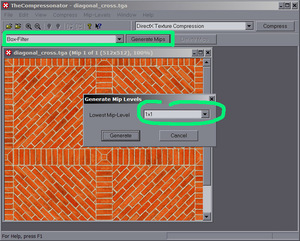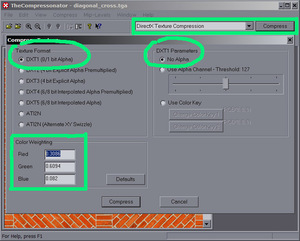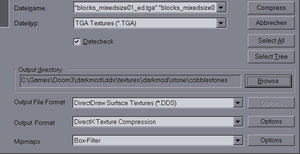DDS Creation with ATI Compressonator: Difference between revisions
Creation, with content moved from 'DDS creation' |
m →AMD's Compressonator: typo's |
||
| (19 intermediate revisions by 2 users not shown) | |||
| Line 1: | Line 1: | ||
''Note - | ''Note - Before August, 2020, a longer predecessor of this content lived at [[DDS creation]]. Go there for a newly-written tool-independent overview of DDS creation.'' | ||
== Introduction == | |||
ATI's "The Compressonator" was important during early TDM development. Now, the version of the program discussed here (indeed, any version under the ATI brand) is old and should not be your first choice, but may still have its uses. See also the "Successors" section at the end. | |||
Find [http://darkmod.taaaki.za.net/tools/ati_compressonator_v1.21.zip "The Compressonator" version 1.21.1044 here]. Install/unzip it to a folder and create a shortcut if you like. (At one time, the foregoing exact version was required, because it alone could compress DXT5 RXGB normalmaps. Compression of normalmaps should no longer be done.) | |||
After running the installer, you will likely find when you try to run "The Compressonator", that the installation was incomplete. To complete it, inspect the distribution .zip for a folder that contains MSVCP71.DLL. With Admin privileges, copy MSVCP71.DLL to where the program lives, typically c:/Program Files (x86)/ATI Technologies Inc/The Compressonator. | |||
Please review [[DDS creation]] for general information about | |||
* working with TGA and DDS, and where files should be placed in your FM | |||
* suggested DDS creation settings | |||
== Compressing Diffuse and Specular Maps == | |||
== | |||
* Open your source (TGA) file | * Open your source (TGA) file | ||
* | * In the Mip Maps toolbar's pulldown, select '''Box-Filter'''. Press "Generate", and then a Lowest Mip-Level size of '''1x1'''. | ||
[[Image:01_mips.jpg|frameless]] | [[Image:01_mips.jpg|frameless]] | ||
* | * In the Compression toolbar's pulldown, select '''DirectX Texture Compression'''. Click the "Compress" button. | ||
* | * Choose the correct compression type: | ||
* | **'''Diffusemap:''' Does the texture have '''transparency'''(i.e., leaves, spiderwebs, etc)? '''NO: DXT1'''. '''YES: DXT5''' | ||
: | **'''Specularmap: DXT1''' - specular does not require alpha information. | ||
: | **'''Normalmap: NONE''' - Use TGA! | ||
: | * Don't change the default channel weighting values of : | ||
* Click Compress | :red=0.3086 | ||
:green=0.6094 | |||
:blue=0.082 | |||
* Click "Compress" | |||
[[Image:02_compression.jpg|frameless]] | [[Image:02_compression.jpg|frameless]] | ||
* Save your DDS to the '''dds/''' tree | * Save your DDS to the '''/dds/''' tree | ||
=== Change the File Extension to | === Change the File Extension to Lowercase === | ||
The Compressonator automatically names the file *.DDS, but all files should be lowercase (including TGAs). Be sure to rename the files to a lowercase .dds extension before | The Compressonator automatically names the file *.DDS, but all files should be lowercase (including TGAs). Be sure to rename the files to a lowercase .dds extension before game testing: | ||
Option A: Use Windows Explorer. You need to change your Explorer settings to display the file extension: | Option A: Use Windows Explorer. You need to change your Explorer settings to display the file extension: | ||
| Line 67: | Line 45: | ||
:ren *.DDS *.dds | :ren *.DDS *.dds | ||
== | == About Transparency == | ||
At this time TDM only supports hard edges for transparency, so you won't get a gradual blending. However, saving the 8-bit alpha channel - and using DXT5 compression - "future-proofs" your material for a day when TDM could support this smooth blending. In the meantime, hard edge clipping occurs by default at 50%; use the the "alphaTest" keyword in your material to easily control this. | |||
When converting from TGA with Alpha to DDS, the alpha doesn't always work correctly. Causes for this vary, but: | |||
* One easy workaround is to save your texture out as a TIFF and then open that in The Compressonator. | |||
* If you are saving from Photoshop/GIMP, disable Layers in the save options, but make sure it's set to preserve transparency. | |||
* When opening it in The Compressonator, right click in the image and view RGBA/Alpha to check that it is correct, before generating mipmaps or compressing. | |||
== Batch Processing == | == Batch Processing == | ||
Choose '''File > Batch Compress''' or hit F4 to open the batch compression dialog. Choose the same compression settings | Choose '''File > Batch Compress''' or hit F4 to open the batch compression dialog. Choose the same compression settings described above, while taking care to separate file groups that use different compression settings. | ||
[[Image:dds_batch_screenshot.jpg|frameless]] | [[Image:dds_batch_screenshot.jpg|frameless]] | ||
== Command Line Parameters == | == Command Line Parameters == | ||
ATI's compressonator provides some command line parameters to compress the textures: | ATI's compressonator provides some command line parameters to compress the textures: | ||
thecompressonator -convert "specular.tga" "specular.dds" DXT1 -mipmaps | thecompressonator -convert "specular.tga" "specular.dds" DXT1 -mipmaps | ||
thecompressonator -convert "diffuse.tga" "diffuse.dds" DXT1 -mipmaps | thecompressonator -convert "diffuse.tga" "diffuse.dds" DXT1 -mipmaps | ||
thecompressonator -convert "diffuse_with_alpha.tga" "diffuse.dds" DXT5 -mipmaps | thecompressonator -convert "diffuse_with_alpha.tga" "diffuse.dds" DXT5 -mipmaps | ||
==Converting From DDS to Common Image File Formats== | |||
==Converting | |||
This is trivial but slightly confusing on The Compressonator: | This is trivial but slightly confusing on The Compressonator: | ||
* File Menu > Save Original | * File Menu > Save Original | ||
* At the bottom of the dialog below the file name input select ''save as type''. It may show DDS by default | * At the bottom of the dialog, below the file name input, select ''save as type''. It may show DDS by default; don't be put off. | ||
* Select file format from BMP, PNG, or TGA (use TGA generally for Dark Mod.) | * Select file format from BMP, PNG, or TGA (use TGA generally for Dark Mod.) | ||
* Make sure the filename you want is shown in the input box and click ''save''. | * Make sure the filename you want is shown in the input box and click ''save''. | ||
== Exploring This Version of ATI's Compressonator Further == | |||
There is a fuller [https://www.katsbits.com/tutorials/textures/making-dds-using-ati-compressonator.php tutorial] available. | |||
The Compressonator has additional Mip-maps and Compress settings not mentioned above. In particular, the "D3D" and "D3DX" settings use the Microsoft DirectX 3D and DirectX 3D Extension libraries. The version discussed above probably uses version 9 of these. More about version 9 mipmap filtering choices can be found at: | |||
* [https://docs.microsoft.com/en-us/windows/win32/direct3d9/texture-filtering D3D9 Texture Filtering] | |||
* [https://docs.microsoft.com/en-us/windows/win32/direct3d9/texture-filtering-with-mipmaps D3D9 Texture Filtering with Mipmaps] | |||
* [https://docs.microsoft.com/en-us/windows/win32/direct3d9/d3dx-filter D3DX Filters] | |||
== Successors == | |||
=== From ATI === | |||
The Compressonator's final version 1.50 from ATI (circa Dec 2008; some sites 2010) supports 64-bit Windows. [https://www.nexusmods.com/oblivion/mods/11852/ Downloadable and Release Notes here]. According to the Release Notes, versions 1.40 - 1.50 use DirectX 3D 10 and its updated Mip-map filtering, and have better support for command line options. | |||
Note that AMD acquired ATI in 2006, and retired the ATI brand by 2010. | |||
== | === AMD's Compressonator === | ||
An up-to-date successor, under Windows 10 and using DirectX 12, "Compressonator 4.0" is an open-source project supportive of AMD's graphic cards: | |||
* | * [https://gpuopen.com/compressonator/ Project Overview] | ||
* [https://github.com/GPUOpen-Tools/compressonator GitHub source code] | |||
* | |||
== See also == | == See also == | ||
* [[DDS creation]] for general, tool-independent information about DDS creation. Also, the original wiki page history of content now on this page may be found there. | * [[DDS creation]] for general, tool-independent information about DDS creation. Also, the original wiki page history of content now on this page may be found there. | ||
* [https://en.wikipedia.org/wiki/D3DX More about the various versions of D3DX] | |||
[[Category:Tutorial]] | [[Category:Tutorial]] | ||
[[Category:Textures]] | [[Category:Textures]] | ||
Latest revision as of 01:26, 3 June 2022
Note - Before August, 2020, a longer predecessor of this content lived at DDS creation. Go there for a newly-written tool-independent overview of DDS creation.
Introduction
ATI's "The Compressonator" was important during early TDM development. Now, the version of the program discussed here (indeed, any version under the ATI brand) is old and should not be your first choice, but may still have its uses. See also the "Successors" section at the end.
Find "The Compressonator" version 1.21.1044 here. Install/unzip it to a folder and create a shortcut if you like. (At one time, the foregoing exact version was required, because it alone could compress DXT5 RXGB normalmaps. Compression of normalmaps should no longer be done.)
After running the installer, you will likely find when you try to run "The Compressonator", that the installation was incomplete. To complete it, inspect the distribution .zip for a folder that contains MSVCP71.DLL. With Admin privileges, copy MSVCP71.DLL to where the program lives, typically c:/Program Files (x86)/ATI Technologies Inc/The Compressonator.
Please review DDS creation for general information about
- working with TGA and DDS, and where files should be placed in your FM
- suggested DDS creation settings
Compressing Diffuse and Specular Maps
- Open your source (TGA) file
- In the Mip Maps toolbar's pulldown, select Box-Filter. Press "Generate", and then a Lowest Mip-Level size of 1x1.
- In the Compression toolbar's pulldown, select DirectX Texture Compression. Click the "Compress" button.
- Choose the correct compression type:
- Diffusemap: Does the texture have transparency(i.e., leaves, spiderwebs, etc)? NO: DXT1. YES: DXT5
- Specularmap: DXT1 - specular does not require alpha information.
- Normalmap: NONE - Use TGA!
- Don't change the default channel weighting values of :
- red=0.3086
- green=0.6094
- blue=0.082
- Click "Compress"
- Save your DDS to the /dds/ tree
Change the File Extension to Lowercase
The Compressonator automatically names the file *.DDS, but all files should be lowercase (including TGAs). Be sure to rename the files to a lowercase .dds extension before game testing:
Option A: Use Windows Explorer. You need to change your Explorer settings to display the file extension:
- Open up Windows Explorer
- Go Tools > Folder Options
- Click the View tab and disable Hide extensions for known file types
Then you can highlight your file and hit F2 (or right-click > Rename) and change the extension to lowercase.
Option B: This can also be done via the command line Start > Run... > cmd (then cd to your textures folder) and rename the files via:
- ren *.DDS *.dds
About Transparency
At this time TDM only supports hard edges for transparency, so you won't get a gradual blending. However, saving the 8-bit alpha channel - and using DXT5 compression - "future-proofs" your material for a day when TDM could support this smooth blending. In the meantime, hard edge clipping occurs by default at 50%; use the the "alphaTest" keyword in your material to easily control this.
When converting from TGA with Alpha to DDS, the alpha doesn't always work correctly. Causes for this vary, but:
- One easy workaround is to save your texture out as a TIFF and then open that in The Compressonator.
- If you are saving from Photoshop/GIMP, disable Layers in the save options, but make sure it's set to preserve transparency.
- When opening it in The Compressonator, right click in the image and view RGBA/Alpha to check that it is correct, before generating mipmaps or compressing.
Batch Processing
Choose File > Batch Compress or hit F4 to open the batch compression dialog. Choose the same compression settings described above, while taking care to separate file groups that use different compression settings.
Command Line Parameters
ATI's compressonator provides some command line parameters to compress the textures:
thecompressonator -convert "specular.tga" "specular.dds" DXT1 -mipmaps thecompressonator -convert "diffuse.tga" "diffuse.dds" DXT1 -mipmaps thecompressonator -convert "diffuse_with_alpha.tga" "diffuse.dds" DXT5 -mipmaps
Converting From DDS to Common Image File Formats
This is trivial but slightly confusing on The Compressonator:
- File Menu > Save Original
- At the bottom of the dialog, below the file name input, select save as type. It may show DDS by default; don't be put off.
- Select file format from BMP, PNG, or TGA (use TGA generally for Dark Mod.)
- Make sure the filename you want is shown in the input box and click save.
Exploring This Version of ATI's Compressonator Further
There is a fuller tutorial available.
The Compressonator has additional Mip-maps and Compress settings not mentioned above. In particular, the "D3D" and "D3DX" settings use the Microsoft DirectX 3D and DirectX 3D Extension libraries. The version discussed above probably uses version 9 of these. More about version 9 mipmap filtering choices can be found at:
Successors
From ATI
The Compressonator's final version 1.50 from ATI (circa Dec 2008; some sites 2010) supports 64-bit Windows. Downloadable and Release Notes here. According to the Release Notes, versions 1.40 - 1.50 use DirectX 3D 10 and its updated Mip-map filtering, and have better support for command line options.
Note that AMD acquired ATI in 2006, and retired the ATI brand by 2010.
AMD's Compressonator
An up-to-date successor, under Windows 10 and using DirectX 12, "Compressonator 4.0" is an open-source project supportive of AMD's graphic cards:
See also
- DDS creation for general, tool-independent information about DDS creation. Also, the original wiki page history of content now on this page may be found there.
- More about the various versions of D3DX


